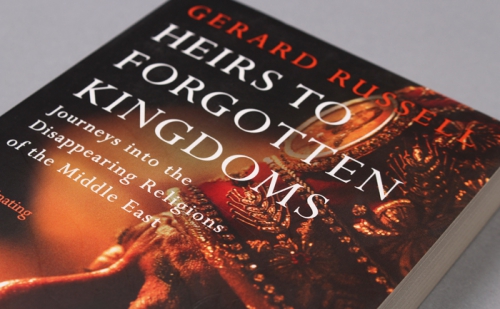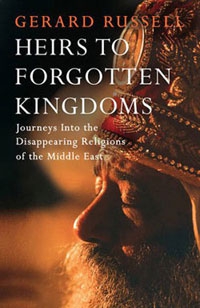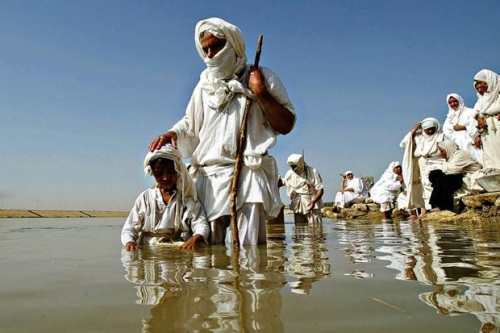jeudi, 05 mai 2016
Interview with Gerard Russell on Heirs to Forgotten Kingdoms

Interview with Gerard Russell on Heirs to Forgotten Kingdoms
Ex: http://www.onreligion.co.uk
 Former British diplomat, Gerard Russell, has published a work looking at the minority religions in the Middle-East.
Former British diplomat, Gerard Russell, has published a work looking at the minority religions in the Middle-East.
Abdul-Azim Ahmed speaks to him.
AA: Thank you Gerard for speaking to us about your book. Could you begin by telling us a bit about yourself?
GR: Sure. I’m a former British diplomat. I’ve been in the Middle East for many years and I learned Arabic. I’ve lived in Cairo, Jerusalem, Baghdad, Jeddah, and Kabul. In each of these places I had encountered these little religions, little communities, which when I looked at them, seemed to have preserved remarkably intact elements of much earlier trends and traditions of human thought. You see these communities, you think ‘this is amazing, this is history alive in the present day!’
AA: Can you tell me more about the religions you looked at, and where they come from geographically?
GR: I looked mainly at the places where I had lived and where I could say something that others perhaps couldn’t. So in Egypt I looked at the Copts, likewise Palestine for the Samaritans – Palestine-Israel I should say particularly as they are the original Israelites. I looked at Lebanon for the Druze, Iraq for the Yazidis and Mandaeans, Iran for the Zoroastrians and also I looked at Pakistan for an outlier group which is very different from the others, which is the Kalasha who live in Chitral in Pakistan.
AA: There was a very gruesome and unfortunate way in which the topic you look at gripped the headlines. In the summer of 2014, the self-styled Islamic State besieged a community of Yazidis in Iraq, and many were asking the question ‘who are the Yazidis?’ Naturally you were well placed to answer.
GR: That’s right. It’s not the first time that the Yazidis have been exposed to this kind of horror. In 2007 there was a massive terrorist attack which killed over 700 of them in Sinjar. So there is something of a history of this. Although it is important to remember that between the Ottomans (who as late as 1880s were behaving abominably to the Yazidis) and the al-Qaida attack in 2007, there was actually a prolonged period of mutual coexistence and inclusion. Egypt 1860 to 1920 is also a good example. There is a very clear trend in those times in which people of all religions in the Middle-East behaved to each other more decently than was sometimes the case in Europe during that era. That is important to remember because the narrative says ‘Muslims are uniquely intolerant’ which simply isn’t true; the reality is that the Middle-East was ahead of Europe in including its Christian and Jewish minorities for many years. The fact that it appears so negative now by comparison, is a product of particular circumstances – it is not inevitable at all!
AA: From that contemporary context, it is interesting to look at the roots as you mentioned. For myself, I find the Mandaeans and Yazidis especially intriguing, because they seem to echo a familiar theology of the three Abrahamic faiths, but have stark differences also. How was your experience of this?
GR: One thing that is interesting about the Mandaeans is that they recognise certain Jewish prophets such as Noah, but not Abraham. So you might think that is peculiar, because Abraham is the patriarch, but in fact they have this in common with many religions of two millennia ago. To the ascetics of the Middle-East, those who wanted a strict morality, they read about Abraham and they weren’t very impressed. The Mandaean rejection of Abraham is interesting because it connects us to that historic era, which is when the Mandaean religion was conceived.
The Mandaeans have an almost impenetrable demonology and cosmology written in their language, which is Babylonian Aramaic. Some of their rituals are thought provoking, such as the tradition of the priest staying awake for seven days and seven nights without eating to become ordained. Likewise, to become a bishop, you have an amazing ceremony where a message is sent to ‘other side’ through a dying person, to gain permission for this particular person’s appointment. Fascinating ideas. Sometimes when I read about these, it really makes me reflect and not just as ‘wow, this is really old’ but ‘wow, this is an interesting concept’. The Yazidis’ belief in Melek Taus is one such thing.
AA: Well maybe that is a point to pick up on. There is a certain familiarity, certainly for Muslims, with the cosmology of the creation of Adam and Eve, of the angels, of the role of Satan. But of course the Yazidis have a much more idiosyncratic understanding of Melek Taus who is associated with the fallen Archangel Iblis. Could you elaborate a bit more on that? It is an almost subversive take on traditional Quranic readings.
GR: Yes, it really is, when you look at certain aspects of Yazidi belief. For example, Melek Taus – he appears to be the Archangel Azazel, or Lucifer, or Iblis as he is called in Islam. The Yazidis use the term Iblis, but not Shaitaan which they see as insulting and in fact it is a taboo.
The Yazidis, like Muslims, believe Iblis rebelled against God, but unlike Muslims, Yazidis believe he was forgiven. That said, if you look back to the ninth century, there were a lot of Sufi movements that explored the idea of Satan in a way that wasn’t entirely hostile. The Islamic saint Rabia al-Basra said she wanted to quench hell, to extinguish the fires of hell, so that none would be good out of fear of punishment. The Yazidis actually say that the fires of hell have been quenched by the tears of Melek Taus’. It is in one sense a radical departure from the Islamic tradition, but in another sense, it is not a million miles away from what some Muslims have sometimes believed.
AA: That similarity, outwardly at least, is comparable to the Samaritans and the Jewish religion. Many people will be familiar with the story of the Good Samaritan, but unaware of the history of the people and their religion.
GR: The Samaritans have a great advocate who travels the world called Benny Tsedaka. They are interesting as they are both Palestinian and Israeli by nationality and politically – this is unique. Although to the outside world they look simply Jewish, it is much complex than that. The word Jewish comes from Judea and the tribe of Judah. The Samaritans are the descendants of a different people from the Northern Kingdom of Israel, supposedly wiped out by the Assyrians in the seventh century BCE. So they see themselves as being a separate people. They are not accepted by traditional Jewish Rabbis who do not regard them as ‘kosher’, as being part of the people of Israel.
The thing that really distinguishes them from Judaism is that whereas the Jews were scattered by the Romans, the Samaritans were largely left alone. It seemed like a blessing to them at the time. Interestingly though, the consequence is that now they almost don’t exist. They never really adjusted to living in diaspora. They have kept the old traditions exactly as they were. They still have a priestly caste, they still have sacrifices, and they keep The Law incredibly strictly. They almost became extinct as there were fewer than 30 of them at one point whereas there are now 771. So they have shown an amazing resilience.
One thing to remember about these religions is that people have predicted their extinction many times before, but they have been proven wrong, they have remarkable resilience. People in the 1840s saying the Druze will no longer have Chiefdoms in Lebanon, well they do. They said in the 1880s the Samaritans won’t last much longer, well they did. Politics changes – the mood can be hostile one year and then ten years later it may not be.

AA: That is a sobering thought, but positive too. That these religions may be more permanent than the transient politics of the region, and may outlive these contemporary catastrophes we see. Moving away from the Levant and Iraq to the Kalasha in Pakistan – could you tell us some more about them? They seem like another tradition that has survived despite the odds.
GR: These groups of course survived for many reasons, among them that there is a willingness in Islam for coexistence, or toleration at least, of other religions. But there were often geographical reasons – such them living in marshes or mountains. Often a conquering force would simply resign themselves to not enter a particular piece of land because it was simply too difficult.
In the case of the Kalasha, they lived in the great mountains of the Hindu Kush. There used to be a whole collection of tribes in that region who practiced what we could describe as an antique form of paganism. It really does involve many gods and sacrifices, ceremonies and dance, wine drinking too! They survived for a long time because of the mountains, and even Tamerlane, who was one of the few who did want to go around and convert people by force, couldn’t subdue them.
A few remaining Kalasha live in Chitral on what are now good terms with the local authorities. It has been a mixed history however. You can read some incredibly passionate books in defence of the Kalasha by Pakistani intellectuals. There were some individuals, particularly a local cleric who wanted to convert them in the 1950s, but they have survived.
AA: Taking a step back, there is a question I have which I wonder if you can shed some light on – is there a particular reason why the Middle East has a larger amount of religious diversity than Europe?
GR: That is a great question. There are a few reasons. One is that it has a very deep past. When Christianity and Islam arrived, the Middle East already had other deeply embedded religions which had philosophies which were very sophisticated and therefore more resistant to conversion than the equivalent in Europe.
The second reason is that historically the Arab Muslims who conquered those areas, they had to establish their own authority while having their own distinct religion. So they didn’t put emphasis on conversion, but they wanted acent for their rule. When Christianity came into Europe, it came via the Romans who had already ruled Europe for 300 years, they didn’t need to be as tolerant.
The third thing, which is partly related to that, is that Islam was quite accepting of other religions (I don’t mean to exaggerate – in actual behaviour, it was very similar to the Christianity in Western Europe) but what was unusual about Islam was that it had this greater level of acceptance of other faiths because of the Quran making it explicit these religions were respected, and this respect extended to religions that you might not immediately think about, such as the Mandaeans, also called the Sabians. And so I think it does prove something very important which is that the history of Islam, in particular the history of Islam when it was at its height in terms of culture and technology, when Baghdad was the capital of the world and the leading civilisation, was a history of religious diversity.
AA: Thank you very much for your time Gerard.
Heirs to Forgotten Kingdoms by Gerard Russell is available for purchase online and in bookstores.
Enjoyed this article? Then please subscribe. It helps us to keep producing quality British religious journalism.
11:06 Publié dans Actualité, Entretiens | Lien permanent | Commentaires (0) | Tags : actualité, entretien, moyen orient, minorités religieuses, religion, yézidis, mandéens, samaritains, druzes, coptes, zoroastriens, irak, syrie, génocide, génocide culturel |  |
|  del.icio.us |
del.icio.us |  |
|  Digg |
Digg | ![]() Facebook
Facebook
Heirs to Forgotten Kingdoms – illuminating the plight of the Middle East’s minorities

Heirs to Forgotten Kingdoms – illuminating the plight of the Middle East’s minorities
This journey by Gerard Russell into the ‘disappearing religions of the Middle East’ is a fascinating record of the end of tolerance
William Dalrymple
Ex: http://www.theguardian.com
 In the spring of 2006, Gerard Russell was a bored British diplomat stewing in the heat of the Green Zone in Baghdad, “a five-mile 21st-century dystopia filled with concrete berms and highway bridges that ended in midair where a bomb had cleaved them”. Then he received a call from the high priest of the Mandeans.
In the spring of 2006, Gerard Russell was a bored British diplomat stewing in the heat of the Green Zone in Baghdad, “a five-mile 21st-century dystopia filled with concrete berms and highway bridges that ended in midair where a bomb had cleaved them”. Then he received a call from the high priest of the Mandeans.
The Mandeans, he knew, claimed descent from Seth, son of Adam, and believed themselves to be the last followers of John the Baptist. They were also said to be the last surviving remnant of the Gnostic sects that once proliferated across the Middle East in late antiquity. In addition, Arab scholars had long recognised them as “the last Babylonians”. It was, writes Russell, “rather like being summoned to meet one of the knights of the Round Table”. He arranged to meet the high priest and his entourage in Al-Rasheed hotel on the edge of the Green Zone.
The encounter had, however, a sad conclusion. The high priest told Russell how the American invasion of Iraq had unleashed a firestorm on his people. The Mandeans had been protected by Saddam Hussein, who saw them as a link to the ancient Babylonian empire that the Ba’athists claimed as the precursor of the modern nation state of Iraq. But during the anarchy after his fall, and the US occupation that followed, life had become impossible. The high priest spoke of the long series of forced conversions, bombings, killings and kidnappings for ransom that had affected his flock since 2002. Now he wanted to transport the entire community to the west: “There are only a few hundred of us left in Iraq,” said the high priest. “And we want to leave. We want your country to give us asylum.”
The slow and still continuing unravelling of the vast multiethnic, multireligious diversity of the Ottoman empire has been the principal political fact of both the Middle East and the Balkans ever since the mid-19th century. Under the capricious thumb of the sultans, the different faiths, tribes and ethnicities of the Ottoman empire had lived, if not in complete harmony, then at least in a kind of pluralist equilibrium: an interwoven patchwork of different communities living separately, yet side by side. But with the Ottoman retreat from the Balkans in the early 19th century, and the eventual collapse of the rest of that empire in the aftermath of the first world war, that patchwork was ripped apart.
Everywhere, pluralism was replaced with a ferocious polarisation. Almost all the former Ottoman lands suffered bouts of savage bloodletting, and some of these – Turkey 1919-21, Palestine 1948, Cyprus 1963-4, Lebanon 1975-90, Bosnia 1991-2, Iraq from 2002 and most recently in Syria from 2011 – grew into civil wars of startling violence and fought along religious faultlines.
In the aftermath of each of these wars, from Sarajevo to Baghdad, in dribs and drabs and occasional tragic exoduses such as occurred with the Yezidis last summer, ethnic and religious minorities have fled to places where they can be part of a majority: the Pontic and Smyrna Greeks to Greece; the Anatolian Armenians to Armenia; the various Jewish communities to Israel – in each case creating religious nationalisms operating in two directions. Those too few for that, such as the Mandeans and Yezidis, have tended to abandon the region altogether, seeking out places less heavy with history, such as North America or Australia. The recent Isis-driven departure of the Yezidis and Chaldean Christians of Mosul is only the latest chapter in a process that began with the secession of Serbia and Greece from Ottoman control in the 19th century, and the subsequent explusion of their Turkish minorities: in 1878, for example, about 130,000 Bosnian Muslims migrated from Sarajevo to areas under Ottoman rule.

Baptism ritual of the Mandeans
Islam has traditionally been tolerant of minorities: the relatively gentle treatment of Christians under Muslim rule contrasts strongly with the fate of Jews and Muslims in, say, 15th-century Spain, forced to flee or convert and even then pursued by the cruelties and tortures of the Inquisition. As Aubry de la Motraye, a 17th-century Huguenot exile escaping religious persecution in Europe, admiringly put it, “there is no country on earth where the exercise of all religions is more free and less subject to being troubled than in Turkey”. The same broad tolerance that gave homes to the Jews expelled from Spain and Portugal also protected the survivors of other religions that preceded Islam: not just Judaism and eastern Christianity, but also Yezidis, Samaritans and Mandeans, as well as relative latecomers such as the Druze and the Alawites.
All this came to an abrupt end after the first world war, and the establishment of a series of ethno-religious Ottoman successor states such as Serbia, Turkey and Israel. Here, citizenship was often conflated with a religious and ethnic identity. In each of these, majoritarianism was the rule, and minorities felt increasingly unloved and unwelcome.
This process has only accelerated in the 21st century, especially in Iraq, Syria and Egypt, where the slow decline of communism and Arab nationalism, “Islamism’s secular competitors”, has taken place in parallel with the rise of fundamentalist Salafi Islam. As Russell observes: “In Egypt, the past 50 years have seen much more violence against the Copts than the previous 50 years had. Iraq, a country ruled in the 1950s by a man of mixed Shi’a-Sunni parentage, is now a maelstrom of communal violence.”
In each case, the situation of the minorities has grown increasingly untenable: the Chaldeans, Mandeans and Yezidis have all had to flee Iraq, the last Armenians have left Syria and the Copts are now haemorrhaging out of Egypt. To the east of Ottoman lands, among the Zoroastrians of Iran and the Kafir Kalash of Afghanistan, there has been a similar process of growing violence culminating in emigration.
There have been good studies of individual parts of the process, but Heirs to Forgotten Kingdoms, Russell’s brilliant and constantly engaging account of his travels through the disappearing religions of the Middle East, is the first attempt to pull all these diverse threads together. His descriptions of dogged believers clinging on in their last shrines may be terse compared with the fully drawn pen portraits one gets from Ryszard Kapuściński or Colin Thubron, but where Russell excels is in his ability to link the past and the present, and to draw from a well of historical and theological scholarship, and his deep erudition in Arabic and Farsi, to show why we must take note of these unlikely survivors from the ancient Middle East, why their emigration matters and how this is likely to affect contemporary politics.
The opening Mandean chapter shows the full range of Russell’s strengths. The Mandeans are usually looked on as the last of the Gnostics, yet he convincingly shows that many of their customs and traditions date from many centuries earlier: their scriptures are written “in a language very close to that used by Jewish scholars who compiled the Babylonian Talmud”. Their music and hymns and their avoidance of meat and alcohol, as well as their suspicion of sex, link them to the Manicheans, whose founder, Mani, was born into a Mandean household. Their use of astronomy and some of their spells, which still invoke the goddess Libat or Ishtar, are inheritances from Babylon.
It is a similar case with the Yezidis. They have long been accused by their Muslim and Christian neighbours of being devil worshippers. This is a crude caricature of a much more interesting and complex esoteric theology, whose worship of the peacock angel, Melek Taus, draws on elements of Assyrian and Sumerian religious beliefs and whose bull slaughter is an inheritance from that early competitor of Christianity, Mithraism. At the centre of their belief is their faith that Melek Taus, having rebelled against God, “extinguished the fires of hell with his tears of repentance and was restored to favour as the chief of all the angels”.
The book, which opens with one dystopia, Baghdad, ends with another: the urban wasteland of Detroit, the unlikely destination of many of these exiles. On the way, Russell takes us on a fascinating and timely journey through the beliefs and predicaments of seven fascinating but little-known religions; as well as the Mandeans and Yezidis, we meet the last of the Iranian Zoroastrians, the Druze and Samaritans lodged uneasily between Israel and the Arabs, the increasingly persecuted Coptic Christians of Egypt and the Kafir Kalash of the Hindu Kush. It’s a long time since I read a travel book that taught or illuminated so much, but its importance is greater than that. Tragically, this book puts on record for the last possible time a once-plural world that is on the verge of disappearing for ever.
• William Dalrymple’s Return of a King: The Battle for Afghanistan is out in paperback.
• To order Heirs to Forgotten Kingdoms for £16 go to bookshop.theguardian.com or call 0330 333 6846.
10:54 Publié dans Actualité | Lien permanent | Commentaires (0) | Tags : yezidis, mandéens, zoroastriens, zoroastrisme, moyen orient, syrie, irak, religion, actualité, minorités réligieuses, druzes, samaritains, coptes, intolérance, génocide, génocide culturel |  |
|  del.icio.us |
del.icio.us |  |
|  Digg |
Digg | ![]() Facebook
Facebook


